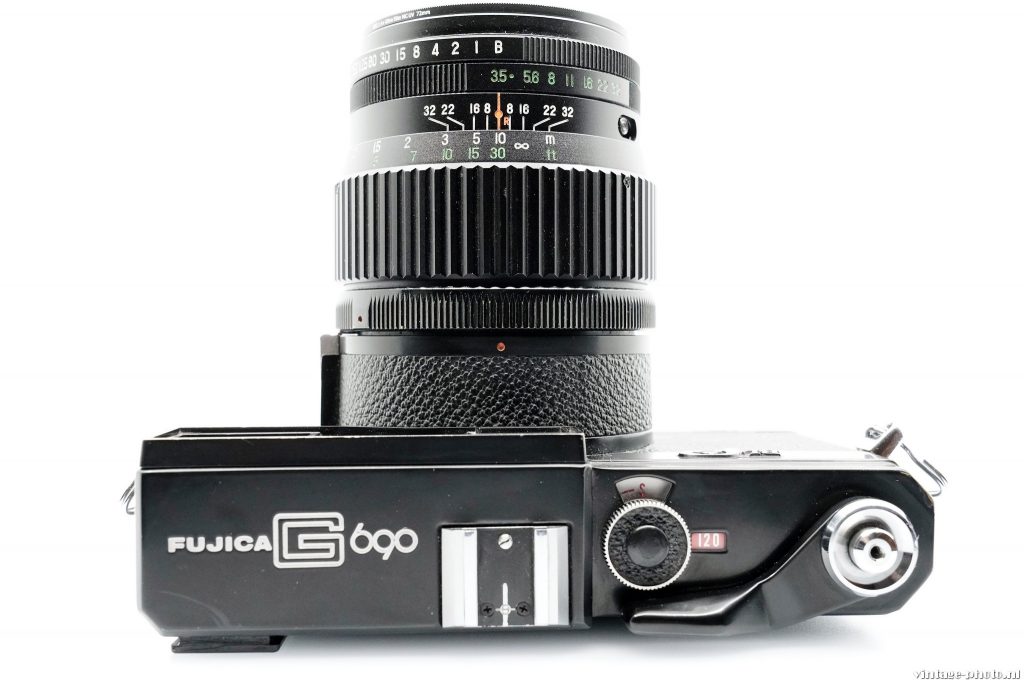Texas: Big, bigger, biggest. Leica: better, best. That’s the idea behind the Fujica G690 from 1969, a medium format camera for the huge 6×9 size. For ‘Leica’ quality, the superior Fujinon lens weighs in. Still it sounds crazy coming from a country where the 35mm SLR was becoming increasingly popular worldwide. Fortunately, Fujica has always remained a maverick.
The camera with lens weighs almost 2kg. The first time you see it, you will be amazed by its size. More than 1.5 times larger than an average SLR. You have to grab your hands well around it to bring the colossal machine in front of your eyes. But after a few minutes of amazement, the real appreciation begins. It is indeed an enlarged Leica-M, the resemblance is present. The shutter lever, the rangefinder and, where on the Leica the shutter speed resides, the Fujica has the adjusting knob for 120 or 220 film. The latter is almost no longer available, but the 120 is still being made.

The rangefinder is also reminiscent of Leica, especially the very bright patch that shows the focus in the centre of the viewfinder. The viewfinder also shows a pair of framelines, in this case for a 100 and 150mm lens. The viewfinder appears small, but looking inwards the magnification of .75 is large enough and clear. The viewfinder is special because it is field-corrected: as the lens is focused, the brightlines adjust not only for parallax but also for field of view. On top of the camera there is only the cold flash/accessory shoe, the transport lever, shutter and the film change lever. But everything is bigger than normal. The front contains the excellent VF/RF and the strange Fujica ‘breechlock’ mount, especially for this camera and fitting lenses.

There is actually nothing on the back. Only a small R/S button and the back cover. The R/S button controls for single or multiple exposures or ‘dry firing’ when there is no film in the camera. The back is opened by turning the lever at the bottom of the camera a quarter turn. Inserting film is easily done by pulling the film from left to right over the large 6×9 window. With the transport button, the film can be winded from shot to shot in two strokes, after which the winding locks so you know when the next negative is correctly in place.

The Fujica does have a shutter curtain but is not a focal plane shutter. The curtain can be opened and closed manually by means of a button at the bottom. A lens can only be changed when this curtain is closed and locked, handy to change the lens halfway as the film stays protected against light. At the same time this is the most vulnerable part of the camera, in many cases this curtain no longer jumps open of aging, but the function can be undone. That brings us to the lens, which contains the leaf-shutter, that can be operated from the camera. So each lens has its own shutter! Handy when you consider that many old cameras always have problems with the shutter. In this case you replace it with another lens. Like other medium format cameras, the fastest shutter speed is 1/500s. However, there is a wide range of shutter speeds all the way to B(ulb). Surprisingly, these all run fairly accurately. Apparently a leaf-shutter wears less. The aperture and focus are also controlled by the lens and focussing is coupled to the rangefinder.

The G series has five lenses. The ‘kit lens’ of 100 mm F3.5, which due to 0.43 crop factor (6×9) corresponds to a 44 mm standard lens on a 35 mm camera. The lens is reviewed as very sharp (even wide open), with good bokeh and very, very sturdy. Also available are the 50 mm and 65mm wide angle and 150mm en 180 mm tele lenses. Flash is also possible with the Fujica, on the lens there is a PC Sync output and a button for M and X sync. The only real improvement of the here showed Fujica G690BL, released in 1969, is the L(ock) to prevent lens removal unless the curtain has been closed. The B stands for the black painted lenses instead of earlier silver ones, P as in all models stands for Professional. We cannot wait to take pictures with this giant and they will follow in the coming weeks. But the first impression is as big as the camera itself, completely manual, in a nice sturdy full metal housing. A light meter is unfortunately missing, but with the Sunny 16 rule it does not prevent you from making extraordinary (big!) pictures that cannot be achieved with any digital successor.


Just scored from Japan on eBay a MOST tragic example of this camera, with the 100, for just BARELY $53 and the same to ship it. My friend thinks it’s salt water damage and I contacted the seller hoping he knows the sad, salty tale and will tell me.